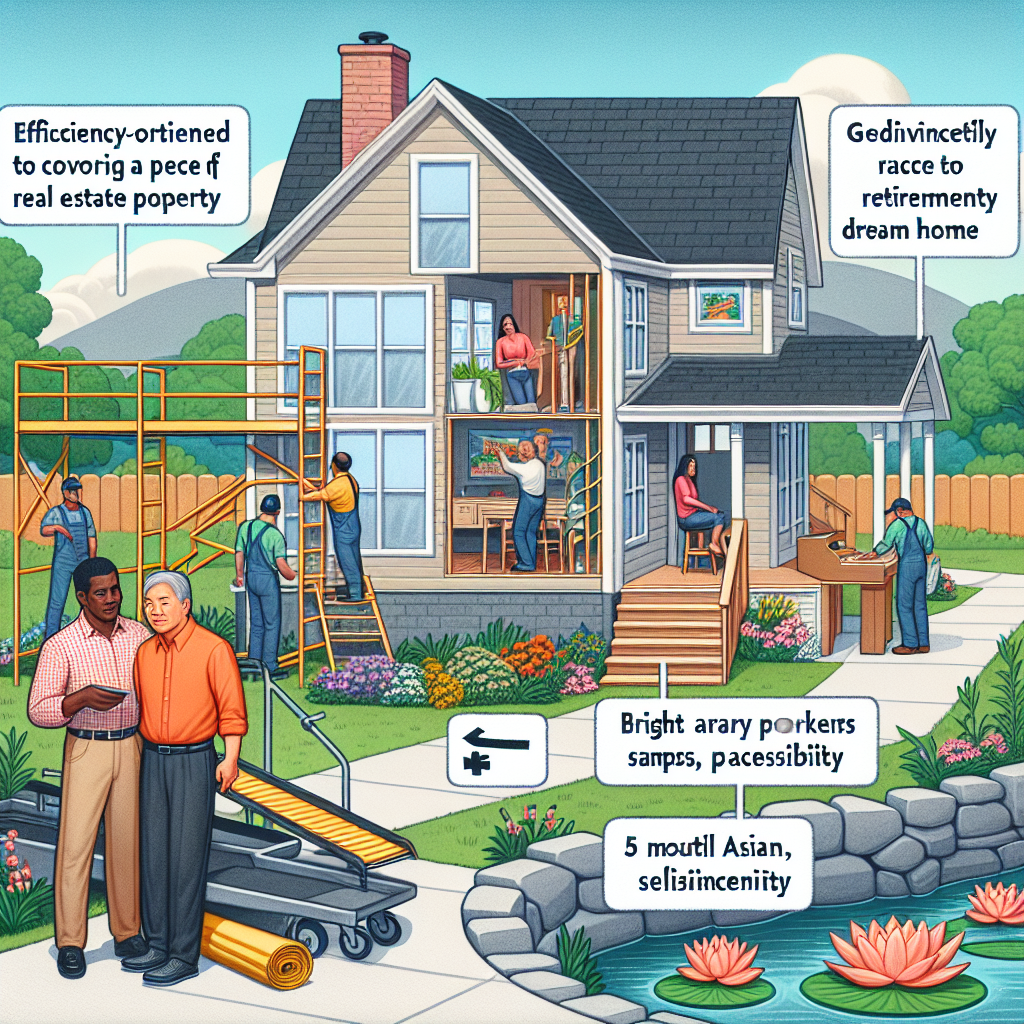-
Table of Contents
- Transforming Unwanted Real Estate into a Retirement Dream for His Parents
- Understanding the Potential of Unwanted Real Estate
- Assessing the Needs and Preferences of Retirees
- Case Study: Transforming an Old Family Home
- Step 1: Planning and Budgeting
- Step 2: Securing Financing
- Step 3: Executing the Renovation
- Step 4: Moving In
- Financial Benefits of Transforming Unwanted Real Estate
- Challenges and How to Overcome Them
- Challenge 1: Budget Overruns
- Challenge 2: Legal and Zoning Issues
- Challenge 3: Emotional Attachment
- Success Stories: Real-Life Examples
- Case Study 1: The Beach House Transformation
- Case Study 2: The Urban Loft Conversion
- Case Study 3: The Country Cottage Revival
- Conclusion: Turning Dreams into Reality
Transforming Unwanted Real Estate into a Retirement Dream for His Parents

In today’s fast-paced world, many individuals find themselves inheriting or owning real estate that they do not need or want. This property can often become a burden, both financially and emotionally. However, with a bit of creativity and strategic planning, unwanted real estate can be transformed into a retirement dream for one’s parents. This article explores the steps, strategies, and success stories of turning an unwanted property into a haven for retirement.
Understanding the Potential of Unwanted Real Estate
Unwanted real estate can come in various forms, such as inherited properties, old family homes, or investment properties that no longer serve their purpose. Before deciding to sell or abandon these properties, it’s essential to understand their potential. Here are some key considerations:
- Location: Is the property located in a desirable area for retirees?
- Condition: What is the current state of the property? Does it require significant renovations?
- Market Value: What is the current market value of the property? Can it be increased with improvements?
- Legal Aspects: Are there any legal issues or restrictions associated with the property?
Assessing the Needs and Preferences of Retirees
Before embarking on the transformation journey, it’s crucial to understand the specific needs and preferences of the retirees who will be living in the property. This involves considering factors such as:
- Accessibility: Are there any mobility issues that need to be addressed?
- Healthcare: Is the property close to healthcare facilities?
- Community: Is there a supportive community or social network nearby?
- Leisure Activities: Are there recreational activities and amenities that align with their interests?
Case Study: Transforming an Old Family Home
Let’s take a look at a real-life example of how an old family home was transformed into a retirement dream for a couple’s parents. John and Sarah inherited a 1950s-era house from John’s grandparents. The house was in a state of disrepair, but it held sentimental value. Instead of selling it, they decided to renovate it for John’s parents, who were nearing retirement.
Step 1: Planning and Budgeting
John and Sarah started by creating a detailed plan and budget for the renovation. They consulted with architects and contractors to understand the scope of work and associated costs. Their budget included:
- Structural repairs
- Modernizing the kitchen and bathrooms
- Installing energy-efficient windows and insulation
- Landscaping the garden
- Adding accessibility features such as ramps and grab bars
Step 2: Securing Financing
To finance the renovation, John and Sarah explored various options, including:
- Home equity loans
- Personal savings
- Government grants for senior housing improvements
- Low-interest renovation loans
They ultimately decided to use a combination of their savings and a low-interest renovation loan to fund the project.
Step 3: Executing the Renovation
The renovation process took several months, during which John and Sarah worked closely with their contractors to ensure everything was done to their specifications. They made sure to incorporate features that would make the home comfortable and safe for John’s parents, such as:
- Widening doorways for wheelchair access
- Installing a walk-in shower with grab bars
- Creating a single-level living space to avoid stairs
- Adding a cozy sunroom for relaxation
Step 4: Moving In
Once the renovation was complete, John’s parents were thrilled with their new home. The transformation not only provided them with a comfortable and safe living space but also preserved the family’s heritage. John and Sarah’s thoughtful planning and execution turned an unwanted property into a cherished retirement haven.
Financial Benefits of Transforming Unwanted Real Estate
Transforming unwanted real estate into a retirement home can offer several financial benefits:
- Cost Savings: Renovating an existing property can be more cost-effective than purchasing a new home.
- Increased Property Value: Improvements can significantly increase the property’s market value.
- Tax Benefits: Home improvements may qualify for tax deductions or credits.
- Rental Income: If the property has additional units, they can be rented out for extra income.
Challenges and How to Overcome Them
While transforming unwanted real estate into a retirement dream is a rewarding endeavor, it comes with its challenges. Here are some common obstacles and strategies to overcome them:
Challenge 1: Budget Overruns
Renovation projects often exceed their initial budgets. To mitigate this risk:
- Set aside a contingency fund for unexpected expenses.
- Get multiple quotes from contractors to ensure competitive pricing.
- Prioritize essential improvements and consider phasing out non-essential ones.
Challenge 2: Legal and Zoning Issues
Legal and zoning issues can complicate the renovation process. To address these:
- Consult with a real estate attorney to understand local regulations.
- Obtain all necessary permits before starting the renovation.
- Work with experienced contractors who are familiar with local building codes.
Challenge 3: Emotional Attachment
Emotional attachment to the property can make decision-making difficult. To navigate this:
- Involve all family members in the planning process to ensure everyone’s input is considered.
- Focus on the long-term benefits of the transformation for the retirees.
- Preserve sentimental elements of the property where possible.
Success Stories: Real-Life Examples
Here are a few more success stories of individuals who transformed unwanted real estate into retirement dreams for their parents:
Case Study 1: The Beach House Transformation
Emily inherited a beach house from her aunt. The property was outdated and required significant repairs. Instead of selling it, Emily decided to renovate it for her parents, who had always dreamed of retiring by the sea. She worked with a team of designers to create a modern, comfortable beach house with stunning ocean views. Her parents now enjoy their retirement in a beautiful coastal retreat.
Case Study 2: The Urban Loft Conversion
Michael owned an old warehouse in the city that he had used for storage. With his parents approaching retirement, he saw an opportunity to convert the warehouse into a stylish urban loft. The renovation included open-plan living spaces, modern amenities, and a rooftop garden. Michael’s parents now live in a trendy, vibrant neighborhood with easy access to cultural attractions and healthcare facilities.
Case Study 3: The Country Cottage Revival
Susan’s family owned a neglected cottage in the countryside. Instead of letting it fall into further disrepair, Susan decided to restore it for her parents’ retirement. The renovation focused on creating a cozy, rustic atmosphere with modern conveniences. Susan’s parents now enjoy a peaceful, idyllic retirement surrounded by nature.
Conclusion: Turning Dreams into Reality
Transforming unwanted real estate into a retirement dream for one’s parents is a journey that requires careful planning, creativity, and dedication. By understanding the potential of the property, assessing the needs of the retirees, and overcoming challenges, it’s possible to create a comfortable and fulfilling retirement home. The financial benefits, emotional satisfaction, and preservation of family heritage make this endeavor truly worthwhile.
Whether it’s an old family home, a beach house, an urban loft, or a country cottage, the possibilities are endless. With thoughtful planning and execution, unwanted real estate can be transformed into a cherished retirement haven, turning dreams into reality for those who matter most.
In summary, the key takeaways from this article are:
- Assess the potential of unwanted real estate before deciding to sell or abandon it.
- Understand the specific needs and preferences of the retirees who will be living in the property.
- Create a detailed plan and budget for the renovation, and explore financing options.
- Overcome challenges such as budget overruns, legal issues, and emotional attachment with strategic planning and professional guidance.
- Draw inspiration from real-life success stories to envision the possibilities for your own project.
By following these steps and strategies, you can transform unwanted real estate into a retirement dream that provides comfort, security, and happiness for your parents in their golden years.








